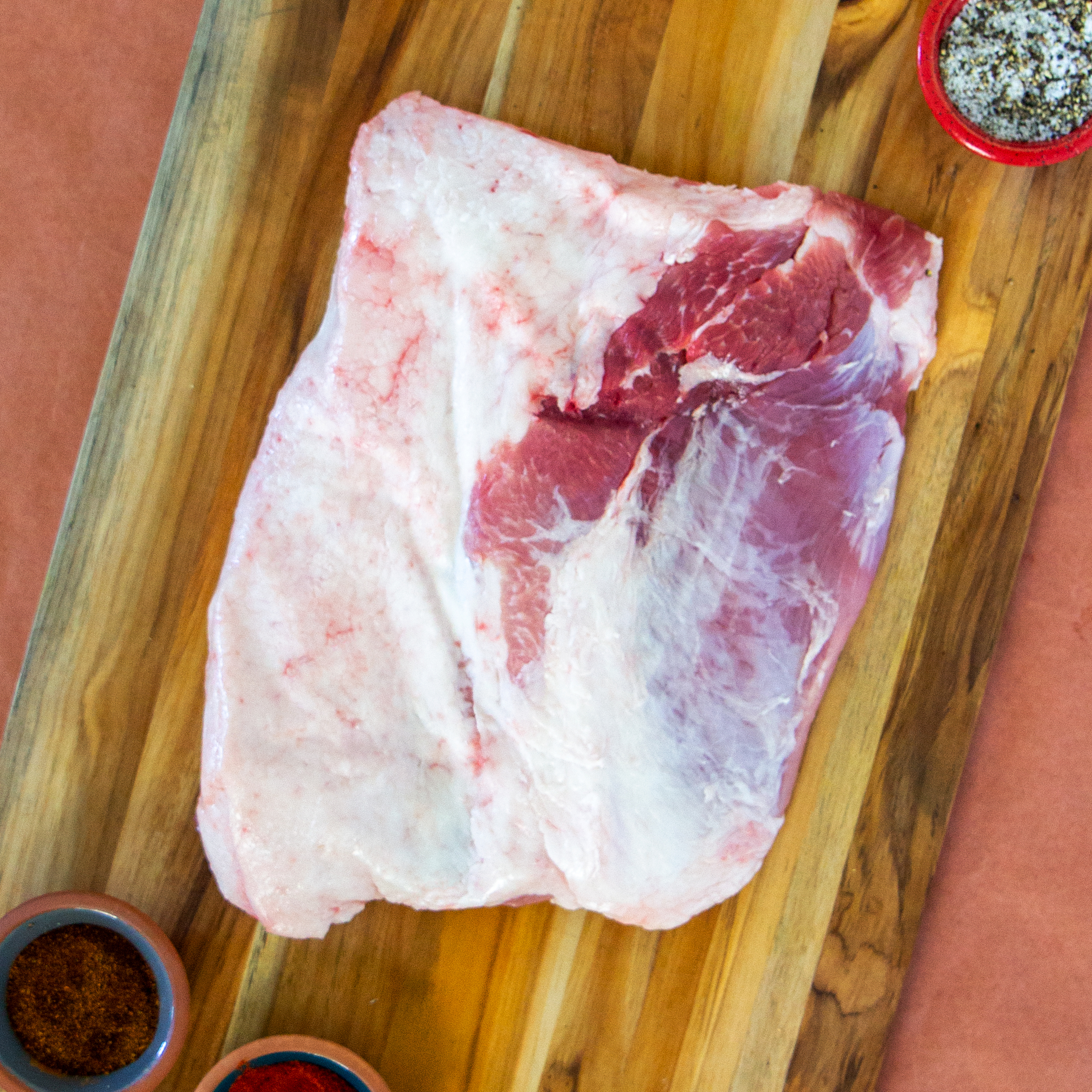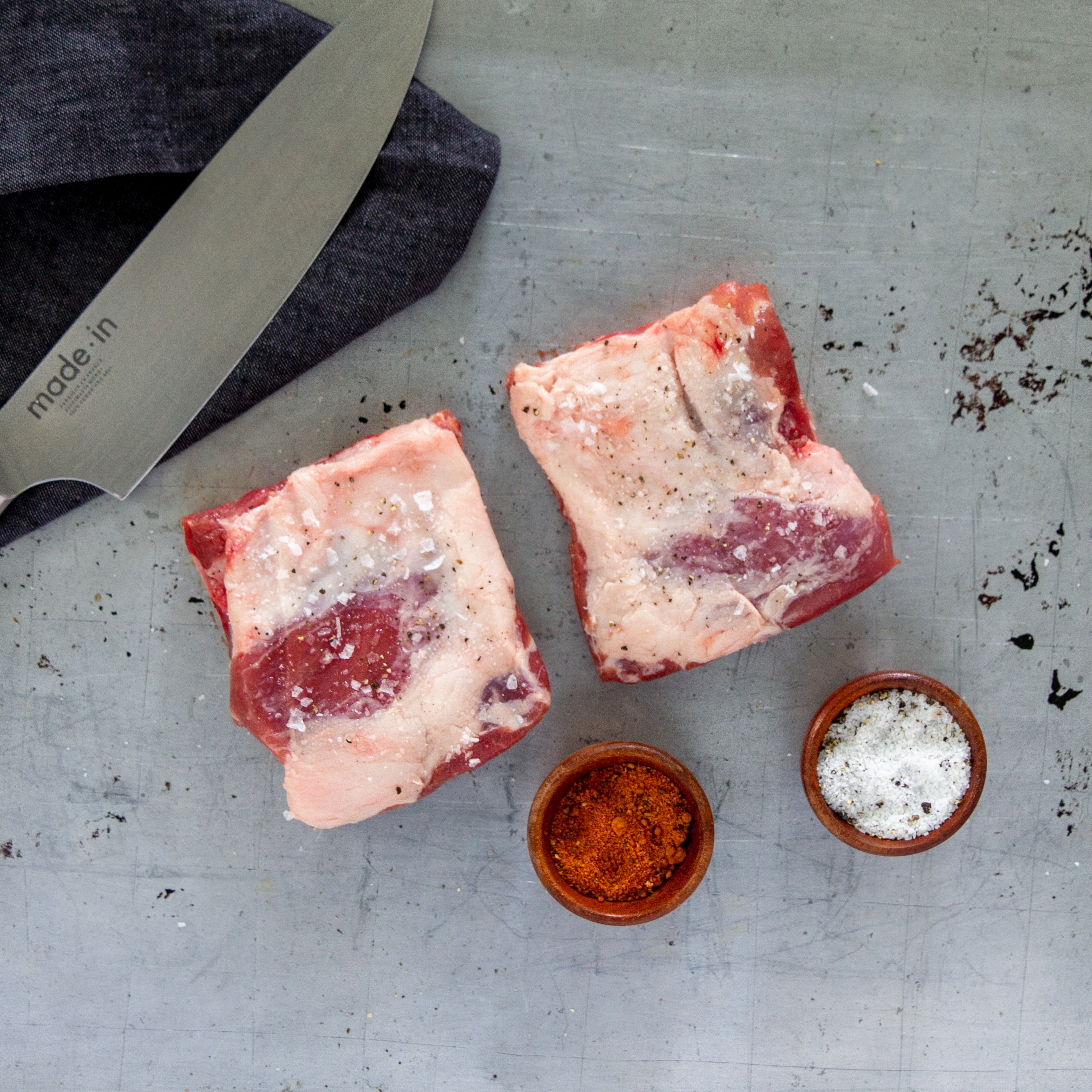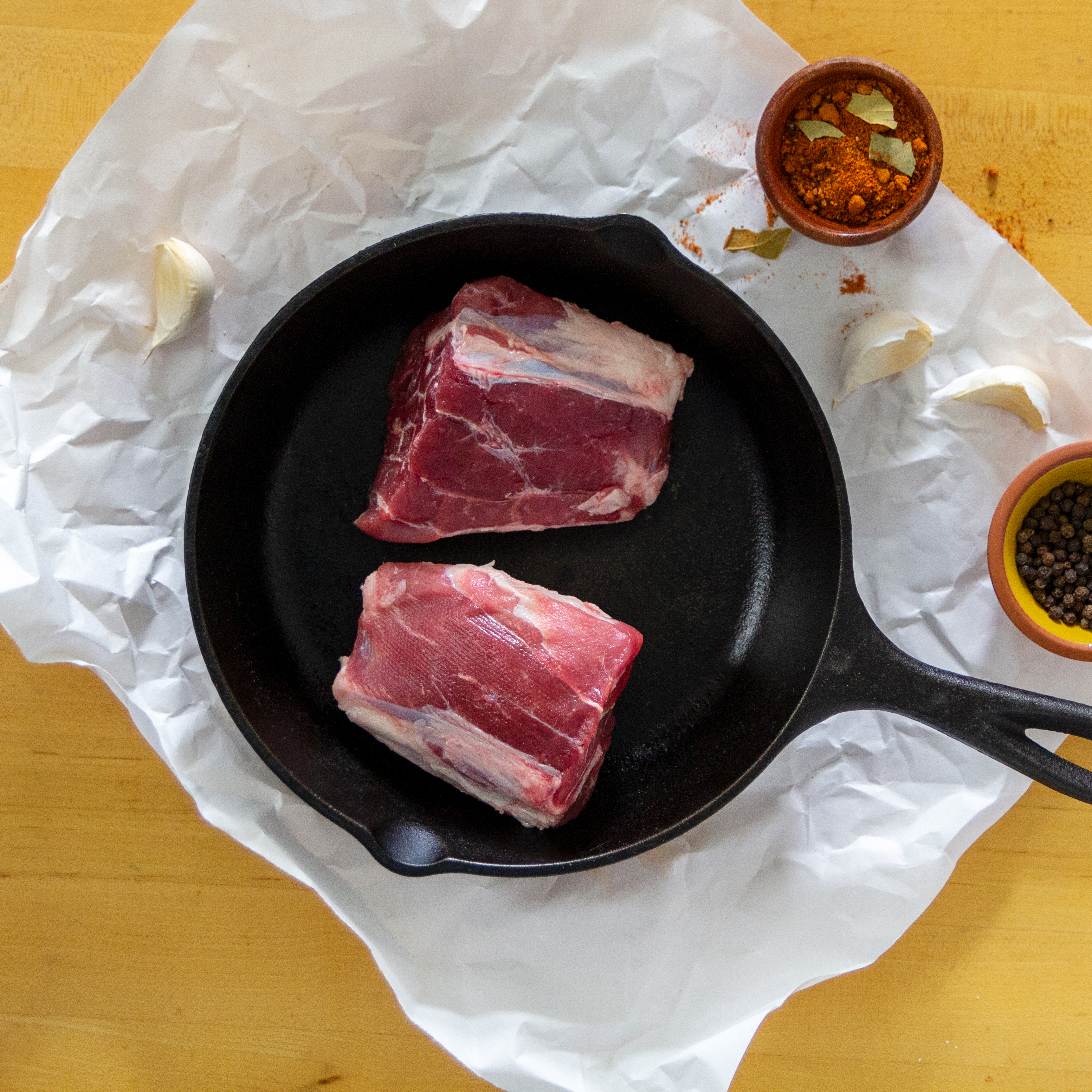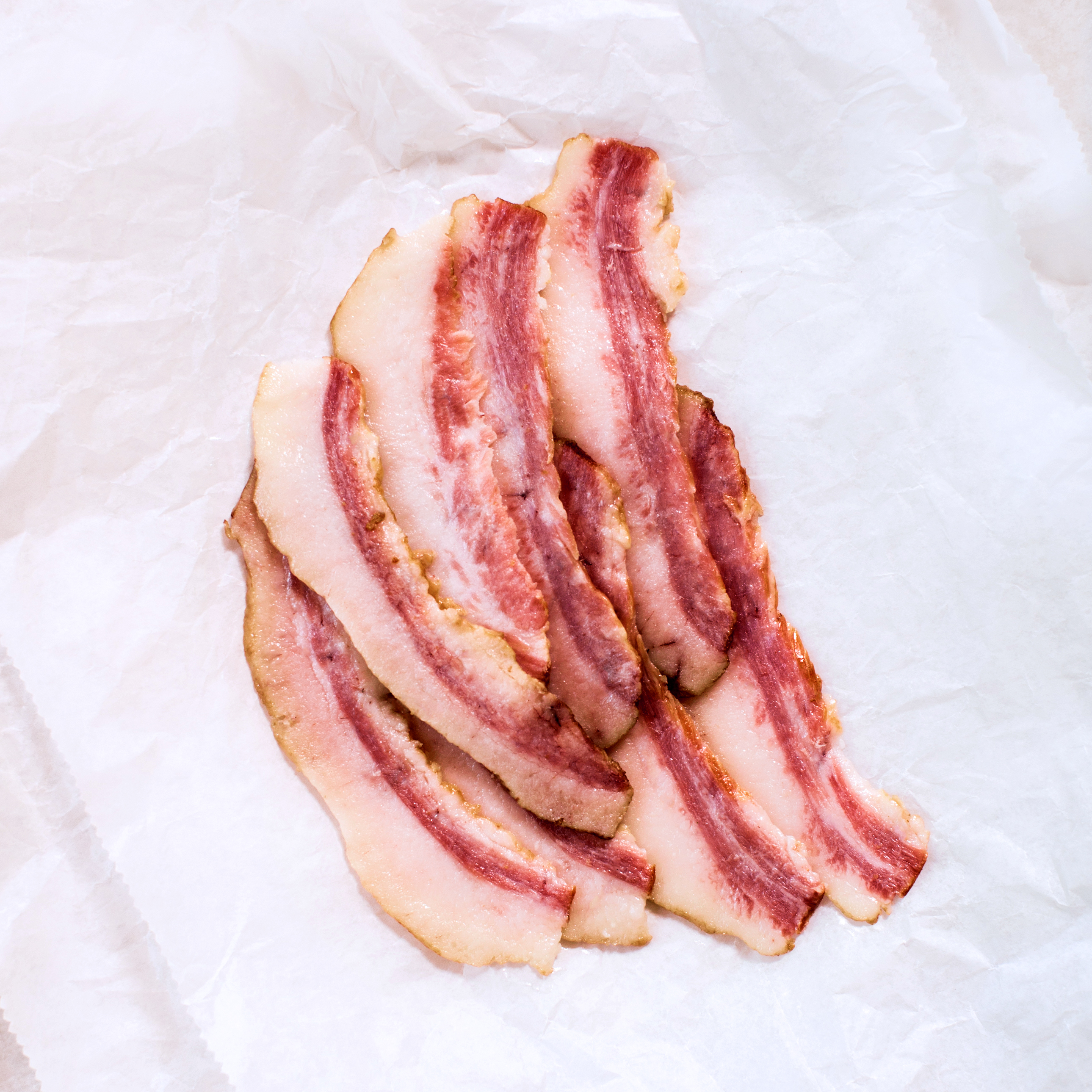In March of 1987, the National Pork Producers Council rolled out an advertising campaign with the theme, ”Pork. The other white meat.”
By attempting to lump pork in with poultry instead of red meat, the council was hoping to appeal to health-conscious consumers who were worried that dining on swine was bad for their waistlines and heart health (it is). What the campaign left out is that the factory-farmed pork the council was promoting came from stressed-out pigs that were essentially being engineered to make paler but less flavorful meat.
“The slogan to me is not a good one because it means we’re confining our animals so they don’t have to use their muscles and they’re basically anemic,” James Peisker, the co-founder of Nashville-based Porter Road tells InsideHook. “The more the muscle works, the darker the muscle becomes. The darker it gets, the more flavorful it gets. Picture chicken thighs versus chicken breasts, because chickens don’t fly. So by saying, ‘Pork, the other white meat,’ you’re saying you confined them and put them in misery, all for the sake of a light chop.”
Porter Road’s pigs, Yorkshire boars crossed with Berkshire sows, are bred and live in the woods in Western Kentucky until they are 60 to 80 pounds over the average weight of the pigs most companies slaughter and then sell. Using those pigs, Porter Road produces standard pork products like sausage, chops and tenderloins, but also has a number of other offerings you might not see at other shops. Below, we got notes from Peisker on four of his favorites: pork brisket, pork short ribs, pork wings and jowl bacon.
Pork Brisket

Porter Road’s pork brisket.
Porter Road
What part of the pig does this come from? Brisket is cut from the pectoral muscle of the pig, an area that gets a great workout on the pasture which helps it build up a ton of flavor. “Pork shoulder gets cut into three different parts,” Peisker says. “The top part is called a butt, the middle part is called a picnic and the bottom part is the shank. We take that picnic cut and take the pectoral muscle off before trimming it down.”
Why is it rare or difficult to harvest? Each animal only has two briskets that can be harvested, and not many butchers take the time to do it. That being the case, this cut typically ends up in the grind for sausage. “Most places don’t cut it out because, to them, it’s not worth the difficulty of making the extra cuts,” Peisker says. “What also makes it rare is, because it’s two solid muscles with a layer of fat on top, it has a nice meatiness to it but still has fat and connective tissue that will break down into gelatin.”
What’s the best way to cook it? Naturally tough but also offering a lot of flavor, pork brisket is made for smoking with a mild wood like cherry or oak. For that matter, it works well with any method of cooking low and slow. “It would do really well in a crockpot with a can of beer and a bottle of barbecue sauce cooked on low,” Peisker says. “That would be delicious and a good alternative if you don’t have a smoker or it’s horrible weather outside.”
What makes it unique or why do people love it? “It’s a sliceable barbecue cut rather than a spreading one, as you’d expect with pulled pork or even ribs where they fall off the bone,” Peisker says. “This is one more you want to cook almost to that 200-degree range, rather than that 207- or 208-degree range. That way it holds together and slices rather than shreds.”
Pork Short Ribs

Porter Road’s short ribs.
Porter Road
What part of the pig does this come from? Like brisket, pork ribs come from the middle part of the shoulder, known as the picnic. “The three-bone rib section actually sits right on top of the brisket,” Peisker says. “It’s a bite-size rack of ribs that typically weighs about half a pound to three-quarters of a pound.”
Why is it rare or difficult to harvest? Obtaining the short ribs requires more cuts and a skilled butcher so, the majority of the time, the ribs will be separated from the bone and turned into sausage. “In some cases, grocery stores will sell these after the bones have been removed and call them boneless country ribs,” Peisker says. “I think some people just really don’t like the bone. or associating that they’re eating meat from a living, breathing animal. With the bones still present, some people will refer to these as bone-in country ribs as well.”
What’s the best way to cook it? Smoking is the preferred method for cooking pork short ribs, as they start tough but become tender when cooked properly. “It’s also a really good cut for braising as well,” Peisker says. “You could do a braised pork short rib over sauteed greens or something like that. It’s just important to cook them low and slow, giving the connective tissue time to melt and the fat to render.”
What makes it unique or why do people love it? As with spare ribs or St. Louis ribs, there’s a lot of fat in short ribs. But since they come from a working area of the animal, they end up being more meat-flavored. “What’s unique is the meatiness of these ribs,” Peisker says. “There’s still inner muscular fat to keep it nice and juicy, but it doesn’t have the layers of meat and fat like a spare rib would. It’s the perfect ratio of fat and meat.”
Pork Wings

Porter Road’s pork wings.
Porter Road
What part of the pig does this come from? Pork wings are cut from the shin of the pig, where the meat is especially dense and flavorful and made to replicate your standard chicken wing. “These are super small and you get two per pig,” Peisker says. “They are bigger than a chicken wing for sure, but each one is probably about six or seven ounces raw and then it’ll cook down.”
Why is it rare or hard to harvest? A fairly new cut, pork wings are only offered by butchers who want to give their customers a fun alternative to chicken wings. “We take the back pork shank. and cut it in a certain way,” Peisker says. “Then, we use our knife skills to whittle it down to where it is a bone that’s shaped like the drum stick part of a wing and leave the meat on it. It’s tedious and you need to have the knowledge of what specific bone you’re looking for.”
What’s the best way to cook it? Deep-frying is an option, as is smoking after seasoning with your favorite BBQ rub. “This cut is incredibly good, but it must be cooked with a little bit of skill and care,” Peisker says. “One of my favorite methods I heard somebody was doing was to cook it in pork fat really low and tender and then they deep fry it and toss it in Buffalo sauce. It does also smoke very, very well. In the past, I’ve smoked the wing for about an hour, tossed it in Buffalo sauce and wrapped it, and then put it back on the smoker for an hour to kind of simmer in that sauce. It was delicious.”
What makes it unique or why do people love it? “This muscle has tons of connective tissue, so when you slow cook it down it ends up getting that gelatinous lip-smacking texture you’re used to with chicken wings,” Peisker says.
Jowl Bacon

Porter Road’s jowl bacon.
Andrea Behrends
What part of the pig does this come from? The jowls are cut from the cheeks of the pigs. “Down South, it’s pronounced ‘jewel,’” Peisker says. “It is literally the front face part of the pig. It’s a layer of fat, incredibly marbled meat and then a layer of fat again. It’s really, really rich, but also super thin and small. Don’t be scared because it’s the face.”
Why is it rare or hard to harvest? Each animal only has two of these small cuts, meaning many butchers don’t feel it’s worth the effort to carefully retrieve and keep intact. “Raw, you’re talking about two pounds, total, one pound per piece,” Peisker says. “There’s a giant layer of glands that we remove to make our jowl bacon more appealing. It kind of grossed me out when I saw all the jowl bacon in the market with the glands still in it. When I tasted it, I was like, ‘This stuff’s super delicious, but I only want the good half, not the fat half.’”
What’s the best way to cook it? You can prepare it in a skillet or bake at 350 degrees to ensure it’s evenly cooked. Out of all the bacon options out there, this is the most tender and has the most fat. “It is an intensely flavored, intensely fatty, salty, smoky, delicious bacon,” Peisker says. “It is really good eaten as is, but it almost turns into a cracker in terms of crispiness because of the fat content.”
What makes it unique or why do people love it? A little bit of this bacon goes a long way, and it’s probably best used as part of a larger dish. “I love this bacon most for cooking,” Peisker says. “If you’re going to make a carbonara or something else where you want a big powerful kick, I think jowl bacon is best for that,”
Subscribe here for our free daily newsletter.
Nota bene: If you buy through the links in this article, InsideHook may earn a small share of the profits.
June 30, 2020 at 08:28PM
https://ift.tt/2NIbnfh
Four Rare Pork Cuts That Butchers Swear By, And Where to Buy Them - InsideHook
https://ift.tt/2RsHZwT
Pork

No comments:
Post a Comment